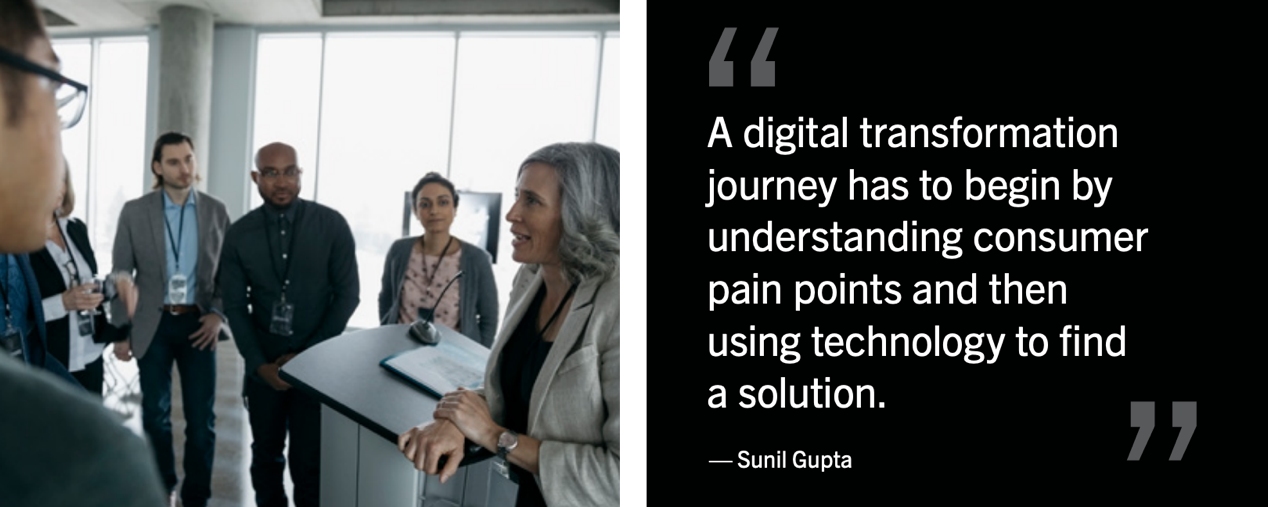
HBS EXECUTIVE EDUCATION | EXECUTIVE INSIGHTS
Summary
Digital transformation must be led from the top. But even the most capable business leaders often miss the mark when it comes to driving digital transformation. Why? Because they don’t properly develop an effective digital strategy. This brief, based on the work of HBS professor Sunil Gupta, outlines a digital strategy framework based on his current research that leaders from across the organization can employ to transform their business.

What Gets in the Way of Digital Transformation?
Business leaders have been talking about digital transformation for two decades. Yet many organizations still struggle to successfully implement the strategy and tactics that a successful digital transformation requires. Why is that?
Ultimately, digital transformation is not about technology. It is about strategy. Because it is a strategic initiative, the responsibility for the success or failure of a digital transformation falls on leadership. Leaders must create a vision of what they want to accomplish and how digital transformation will help them achieve that vision—fundamentally rethinking how to create and capture value, interact with customers and solve their pain points, and recreate the organizational structures necessary to support their strategic vision.
So, where do things go wrong? There are three main obstacles that often prevent organizations from implementing a successful digital transformation.
1.ADOPTING AN OUTMODED, OBSOLETE APPROACH TO T E C H N O L O GY
Oftentimes, organizations leverage technology primarily to cut costs and improve efficiency. While this may result in operations becoming more efficient, the organization as a whole becomes more irrelevant, because they focused on efficiency, not addressing customer pain points.
2 . R E LY I N G TO O H E AV I LY O N E X P E R I M E N TAT I O N
While experimentation is a necessity to better understand how customers will react to different messaging and products, many organizations fall into the trap of experimenting for experimentation’s sake, without first setting a clear vision of what they are ultimately trying to accomplish.
3 . C R E AT I N G S M A L L S P I N - O F F G R O U P S F O C U S E D O N T R A N S F O R M AT I O N
In an effort to achieve transformation faster, many organizations create small task forces or units that operate separately from the main organization, often in a different building (or even in a different state). Dedicated innovation teams work in these spin-off units, with the hope of creating something groundbreaking. Unfortunately, the data show that very few successes come out of these spin-offs because they are ultimately unable to operate in alignment with the larger organization.

“Through initiatives like these,” Gupta writes in his new book, Driving Digital Strategy: A Guide to Reimagining Your Business, “managers are using a Band-Aid for a deeper problem. In order to be successful, you can’t just create a separate digital unit, or run experiments, or use technology to improve your efficiency. Instead, you must make digital strategy an integral part of your overall business strategy.” What Must a Successful Digital Strategy Address? THE STRATEGY Traditionally, business strategies are focused on the product. How can I make my product better, more convenient to use, more practical, less expensive, etc. A digital strategy, however, shifts focus to the customer. According to Gupta, “[A] digital transformation journey has to begin by understanding consumer pain points and then using technology to find a solution. The focus on addressing consumer pain points led Jeff Bezos to obsess about reducing friction in commerce.” Under old business models, business strategy was simple: Make the product better and/or make it cheaper—the focus was on selling a single product to a single customer. But what if you’re selling multiple products to the same customer? Amazon, for example, sells Kindles. But they don't need to make money from the Kindles because they make their money selling the books people read on the Kindles. They employ a strategy in  which the physical unit (the Kindle) can be sold at a break-even price or even at a small loss in order to make money repeatedly selling ebooks for an indefinite period of time. Therefore, the performance of such a strategy cannot be measured based on the profitability of the physical product (the Kindle); the goal is not to make money on the Kindle itself, but rather to sell more ebooks. Furthermore, digital transformation isn't just about using more technology or digitizing processes. It's also about responding to disruptions caused by digital transformation in the marketplace. Best Buy is a perfect example of a company that was disrupted by digital transformation. Like many retailers, the company was losing a lot of business to Amazon. Customers would visit Best Buy stores to examine merchandise, but then buy the merchandise on Amazon for less money. The value Best Buy provided was showcasing merchandise, but this value was not being captured. Digital
which the physical unit (the Kindle) can be sold at a break-even price or even at a small loss in order to make money repeatedly selling ebooks for an indefinite period of time. Therefore, the performance of such a strategy cannot be measured based on the profitability of the physical product (the Kindle); the goal is not to make money on the Kindle itself, but rather to sell more ebooks. Furthermore, digital transformation isn't just about using more technology or digitizing processes. It's also about responding to disruptions caused by digital transformation in the marketplace. Best Buy is a perfect example of a company that was disrupted by digital transformation. Like many retailers, the company was losing a lot of business to Amazon. Customers would visit Best Buy stores to examine merchandise, but then buy the merchandise on Amazon for less money. The value Best Buy provided was showcasing merchandise, but this value was not being captured. Digital
Digital transformation isn’t just about using more technology or digitizing processes. It’s also about responding to disruptions caused by digital transformation in the marketplace.

Under old business models, business strategy was simple: Make the product better and/or make it cheaper—the focus was on selling a single product to a single customer. But what if you’re selling multiple products to the same customer? Amazon, for example, sells Kindles. But they don't need to make money from the Kindles because they make their money selling the books people read on the Kindles. They employ a strategy in which the physical unit (the Kindle) can be sold at a break-even price or even at a small loss in order to make money repeatedly selling ebooks for an indefinite period of time. Therefore, the performance of such a strategy cannot be measured based on the profitability of the physical
product (the Kindle); the goal is not to make money on the Kindle itself, but rather to sell more ebooks. Furthermore, digital transformation isn't just about using more technology or digitizing processes. It's also about responding to disruptions caused by digital transformation in the marketplace. Best Buy is a perfect example of a company that was disrupted by digital transformation. Like many retailers, the company was losing a lot of business to Amazon. Customers would visit Best Buy stores to examine merchandise, but then buy the merchandise on Amazon for less money. The value Best Buy provided was showcasing merchandise, but this value was not being captured.
Best Buy had to respond strategically to stay relevant in this new value chain. They realized that showcasing products created value for the manufacturers because people bought them after seeing and touching them. Once Best Buy recognized that the value they provided was being realized by the manufacturers, the company began charging manufacturers to have a space in their stores to showcase their products. By thinking differently about the way to capture value, Best Buy figured out how to adapt to a new landscape defined by digital transformation, and forged a new working dynamic with their partners and customers. THE VALUE CHAIN In order to achieve a defined strategic goal, you need to reevaluate every aspect of your business, from R&D and operations to supply chains and distribution. As the world moves from bricks to clicks, companies are struggling to develop an effective omnichannel strategy. How should an insurance company that has traditionally sold its products through independent brokers, avoid channel conflict as it introduces its products in the online channel? Are offline and online channels substitutes or complements? One insurance company used the online channel as a customer acquisition tool by selling simple products. Over time, these customers were transferred to offline brokers who could advice and sell them complex products. Walmart has started leveraging its network of stores that Amazon and other ecommerce players can’t match. THE CUSTOMER AND CUSTOMER ENGAGEMENT Transforming customer engagement means focusing on customer experience. And focusing on the customer experience means that you understand your customers’ pain points and are solving a real problem for your customers. Companies such as Audi and Tesla have tackled a real customer pain point with related efficiencies for dealerships. For about a century, the model for car dealerships has remained largely the same: Independent franchises sell a single company’s models on large lots stocked with hundreds of cars. These lots are located outside of city centers in order to save on real estate costs, and customers travel to them to examine vehicles, test drive them, negotiate
prices, and make purchases. The average person doesn’t enjoy the experience of buying a car; they find it stressful, time-consuming, and often confrontational. But until recently, this was the most logical way for car buyers and sellers to do business. However, when it comes to automobiles, consumer buying behavior has changed dramatically over the last decade. Rather than visiting multiple dealerships and comparing and contrasting features and prices, buyers now research the vehicles online two to three months before even visiting a dealership. By the time they come to the dealer, they already know everything about the car and the various options they want to buy. Tesla and Audi have adapted to this new dynamic. Instead of having traditional dealerships on large lots, Tesla has showrooms in busy shopping areas. In several cities around the world, Audi is also launching small showrooms in busy streets. These showrooms display few cars and have a lot of multimedia screens for consumers to configure and customize their vehicles to their liking. This novel approach was all started by asking, "How many people like going to the dealership?" not "What does the future car dealership look like?" You start by understanding the consumer pain point, then work backward to solve for it. In the near future, dealers might begin bringing vehicles to their potential customers’ homes for test drives. In addition to the novelty and convenience for customers, this would further minimize the need for showroom space and overhead costs.

THE ORGANIZATION ITSELF
The decisions you make about your strategy, your new operational model, and your approach to customer engagement will define the type of organization you need. The questions you need to ask yourself are: 1. How does my organization need to be structured to support my strategy? 2. What organizational capabilities do we need to execute on the strategy? 3. How can learning and development drive organizational growth, flexibility, and resiliency?
Who Leads the Way?
In a recent interview, Sunil Gupta said, “Digital transformation touches every aspect of a business— its strategy, operations, customers, and organizational structure. Therefore, it has to be driven by the CEO. In many cases, a CEO creates a team to develop a digital strategy, but its ultimate success depends on the CEO’s commitment to drive this change.” However, as Gupta also points out, it isn’t easy. “[A barrier to digital transformation] is the inability of many senior leaders to deal with the ambiguity and flexibility that this environment demands. As one senior executive told me, [a] digital transformation roadmap is like climbing a ladder in a fog; you know the general direction of where you are going but you can’t see more than 4–5 steps ahead of you, and as you climb the ladder the next few steps become clear that may require a shift in your direction and strategy.” There is no silver bullet. At the end of the day, you need to systematically go through these different components, whether you are dealing with your strategy, your operations, or your customers. It is a laborious and less than exciting process. But if you don’t do it, you won’t be able to keep up with your competitors who do. The business leaders who are able to create and cultivate a vision of what they want to accomplish, understand the consumer pain points they need to alleviate, and reimagine how to create and capture value, will be the ones who set new standards and expectations in their industry and drive the evolution of their market.
ABOUT THE AUTHOR
Sunil Gupta is the Edward W. Carter Professor of Business Administration and cochair of the executive education program, Driving Digital Strategy.